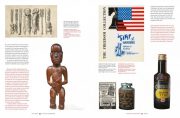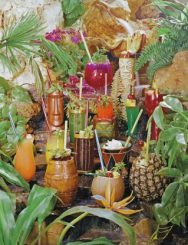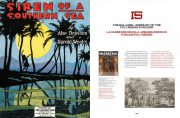The 1960s in the United States saw the peak of the Tiki craze, the fascination with physical products of Polynesia and, more important than that, the easy and happy way of life, as it was glorified by the American public.
There actually was a very strong influence of Tiki culture on American everyday life then, be it in design, architecture, cocktail culture or partying.
 (When this book hit the stores, there was a huge Tiki Pop exhibition at the Musée du quai Branly in Paris until September 28, 2014. The book serves as the exhibition’s catalog.)
(When this book hit the stores, there was a huge Tiki Pop exhibition at the Musée du quai Branly in Paris until September 28, 2014. The book serves as the exhibition’s catalog.)
Unlike the two other excellent books by author Sven Kirsten (also from Taschen), this one follows a straight order, making it the most organized one of Kirsten’s publications.
Tiki Pop in 36 separate chapters deals with Hawaiian music, the Tiki myth (historical and modern), Hollywood’s idea of the South Seas, hula dance, rituals, architecture, carving, the decline and revival of the style amongst other topics.
The Tiki, a name given to almost any Polynesian idol of stone, wood or clay sculptured by the master artists of the many islands was omnipresent in their native cultures, and so we find Tiki idols in places like Tahiti, New Zealand, Hawaii and even on Easter island. The idols, produced out of respect for the gods and ancestors, were part of the cultures for centuries.
The roots of this longing for a certain “innocence” and maybe a lost Eden originated in the 1780s, when European ship crews by chance discovered the Polynesian islands. The reports, drawings and items these crews returned to the continent, initiated a thirst for the entirely different societies so remote from western civilization.
When in 1959, Hawaii became the 50th state of the US, many Americans were certain they had found access to secrets of easy living, lost by western civilization long ago. While actually, they only found a few remains of a once rich culture, the majority of the artifacts and idols were destroyed when almost all parts of Polynesia became the victim of Christian missionaries who, among an endless list of crimes and cruelties, banned not only the cults, but destroyed the idols, prohibited the Hawaiian language and the hula.

Anyway, Americans in the 1960s fantasized about the sexual, exotic and comfortable alternative state of existence; in fact, to the extent that at continental US restaurants, bars, motels, highway sings, tableware, cigarette lighters, soap, buildings and many other items suddenly were designed Tiki style, with carvings, masks and outlandish patterns.
While at that time there was no critical evaluation of the origins of the style, people simply took it as expression of a more relaxed way of life, sexual fantasies, fun and good food. As usual, the dominant/conquering culture here too simplified most relations, histories and meanings, so most Americans identified the countless images of Tikis on products with pleasure and good luck.
Unfortunately, the fascination with Tiki abruptly ended in the late 60s, and bars, motels and restaurants were redesigned, and countless tiki items were either put in storage or thrown out. Tiki Pop has hundreds of pictures ready to document all of those stages.

It is worth mentioning that Sven Kirsten is actually the foremost expert on the planet, when it comes to Tiki culture and Polynesian pop archeology; the only other name with equal reputation then would be famous American Tiki artist SHAG.
With this beautiful and heavy book both the beauty of the exhibits as well as tons of information on the origins, development and aftermath of the style are transferred.
(This review covers the bilingual English/French edition).
Review by Dr. A. Ebert (c) 2014
Sven Kirsten. Tiki Pop. America imagines its own Polynesian Paradise. Taschen, 2014, 384 p. ISBN 978-3-8365-4851-9
